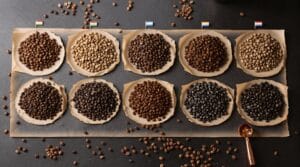Moka pots brew coffee using steam pressure (0.3-2 bars) from stovetop heat, producing strong, bold coffee with nutty notes, while espresso machines pump water at 6-15 bars through ultra-fine grounds, creating thick, creamy shots with intense chocolate or fruit flavors. Moka pots cost less ($45-$70), last decades with simple rinsing, and work without electricity, whereas espresso machines ($100-$1,000+) demand fine-tuning skills, frequent descaling, and pricier maintenance. Craving a deeper comparison? There’s more brewing below.
Brewing Mechanism and Process Overview

While both devices crank out bold, Italian-style coffee, they work like night and day.
The moka pot brewing mechanism is a stovetop showstopper: boiling water in its base chamber builds steam pressure, shooting water up through a loose bed of medium-fine coffee grounds, no tamping needed, settling in the top chamber like a tiny coffee waterfall. Proper pre-boiled water preparation ensures optimal extraction without scalding the grounds. It’s a no-fuss, three-chamber ballet.
Meanwhile, the espresso machine brewing mechanism is a high-tech beast, blasting water (9 bars of pressure!) through finely ground, firmly packed coffee in a portafilter, like a coffee karate chop.
Espresso machines slam 9 bars of pressure through a tamped puck, transforming fine grounds into liquid lightning via portafilter alchemy.
Coffee grind and preparation matter: moka pots crave chill, shake-it-flat grounds, while espresso demands a fine, tamped-down puck.
One’s a campfire storyteller, the other a lab experiment—both brew magic, just different wands.
Pressure Differences and Extraction Impact

Moka pots push water through coffee using steam pressure, around 0.3 to 2 bars, making a bold, strong brew without the creamy “crema” of espresso machines. The brewing process in moka pots operates at near boiling temperatures, which risks over-extracting grounds and creating a burnt flavor if left too long on heat.
Espresso machines blast water at 6 to 15 bars with pumps, squishing oils and flavors from the grounds for richer, smoother shots, like a coffee firehose versus a garden hose.
Lower pressure in moka pots can lead to uneven extraction or bitterness if the grind’s too fine, while espresso’s precise pressure needs perfectly-tuned grounds to avoid sour or weak results.
Pressure Levels Compared
Pressure plays a starring role in coffee brewing, turning water and grounds into something amazing. In the moka pot vs espresso debate, pressure levels generated split them apart.
Moka pots, classic stovetop espresso tools, create 0.3–2 bars using steam from boiling water—enough to push brewed coffee upwards but far below the 9–15 bars espresso machines achieve with electric pumps. These sky-high pressures blast water through finely ground coffee, squeezing out oils and creating that signature creamy crema. The lower pressure in moka pots results in less efficient extraction, producing a coffee that’s strong but lacks the viscosity and emulsified oils of true espresso.
Think of moka pots as the laid-back cousin: lower pressure means no crema, but a bold, strong brew. Espresso machines demand precision, while moka pots thrive on simplicity.
Whether chasing espresso’s intensity or moka’s rustic charm, pressure writes the rules—just don’t forget your grind size!
Extraction Process Variance
Building on the role of pressure in brewing, the way each device pulls flavor from coffee grounds couldn’t be more different.
A moka pot coffee vs espresso showdown hinges on extraction mechanism differences: stovetop espresso maker vs machine. Moka pots use steam pressure (1-2 bars) from boiling water to push hot, steamy water through grounds, but this slower process risks uneven extraction or harshness if left too long. The typical moka pot extraction temperature reaches boiling temperatures (around 100°C), which can further complicate flavor balance.
Espresso machines blast compacted grounds with 9 bars of pump-driven force, yanking out oils fast for balanced, bold sips. Heat plays rough too: moka pots brew at boiling temps, risking burnt notes, while espresso machines keep water cooler (92-96°C) to avoid scorching. The French Press method, known for its immersion brewing technique, offers yet another unique way to extract flavors from coffee grounds.
Want magic foam on top? Thank espresso’s high pressure for crema; moka’s steam can’t compete.
Flavor Profiles: Intensity and Complexity

Espresso machines brew super-strong coffee, with bold, layered flavors like chocolate, fruit, and caramel that hit your taste buds all at once.
Moka pots make coffee that’s strong too, but smoother and simpler, focusing on nutty or roasted notes without the fancy layers.
Espresso can balance bitter and sweet perfectly, while moka pots avoid harshness if brewed right, giving a cozy, no-fuss cup every time.
Brew Strength Differences
When comparing coffee strength, three things matter most: how the coffee is pressed, how long it takes to brew, and how much ends up in your cup.
A moka pot creates strong, bold coffee using steam pressure (1-2 bars)—too low for true espresso, which needs 9 bars. This pressure gap means moka coffee is roughly double as strong as drip coffee but lighter than espresso’s punch. The type of brewing method used also influences the overall flavor profile.
Espresso machines work fast, 25-30 moments, pulling out oils and sugars that build creamy *crema*, while moka pots brew longer, making bittersweet, heavy-bodied coffee.
Though a moka pot doesn’t make real espresso (despite claims), its 50-100ml servings let you sip like a relaxed Italian, while tiny espresso shots hit hard in one go.
Notably, the moka pot’s simple mechanical design contributes to its exceptional durability and longevity, making it a reliable choice for coffee enthusiasts.
Choose your weapon!
Flavor Layering Techniques
Coffee’s flavor layers—boldness, sweetness, or hints of chocolate—come alive through two paths: pressure and heat. Espresso machines and moka pots take these elements in wildly different directions.
1. Pressure builds drama: Espresso machines blast grounds with ~9 bars of pressure, squeezing out bold, sharp layers—think bright citrus, caramel swirls, or floral whispers—all topped by a creamy crema.
Moka pots use gentle steam pressure, blending flavors into a cozy, nutty richness, like a warm hug from a caramel-coated chestnut.
2. Heat shapes the story: Espresso’s precise temperature control highlights fruity or floral notes without burning them.
Moka pots brew hotter, caramelizing sugars into deeper, roasted vibes—like a campfire marshmallow, toasty but risky if left too long. This brewing dynamics leads to a unique sensory experience that reflects the flavor compounds extracted through different methods.
3. Grind size directs the show: Espresso’s ultra-fine grind pulls flavors fast and clear, while moka’s coarser grind lets earthy, chocolatey notes steal the spotlight, smooth but less defined.
Bitterness Versus Sweetness Balance
The dance between pressure and heat doesn’t just build flavor layers—it decides whether your cup tilts toward bold bitterness or smooth sweetness.
Moka pots, brewing at low pressure (1-2 bars), risk over-extracting grounds with boiling water, leaving a sharp, bitter edge if left too long. Stopping the brew as coffee gurgles keeps harshness low.
Espresso machines, blasting at 9 bars, extract coffee faster, pulling out sugars and oils for a balanced bite with natural sweetness, enhanced by the creamy crema layer.
Moka pots lean dark and nutty, their boldness hiding subtle sweetness unless diluted or paired with milk. Espresso’s intensity magnifies flavors, making both its sweetness and bitterness pop—mastering technique tames them.
Choice? It’s freedom: quick, rugged depth or precision-crafted complexity.
Cost Comparison: Initial and Long-Term Expenses
Moka pots and espresso machines battle over budgets as much as flavor. While both brew bold coffee, their costs split like a basic coffee versus a fancy latte.
- Upfront price punch: Moka pots cost $45–$70 (nice!), while espresso machines start at $100–$200 for basics, with fancy models hitting $1,000+ (yikes).
- Daily dollars: Moka pots need just stove heat and cheaper, medium-ground coffee. Espresso machines gulp electricity, demand pricier fine-ground beans, and beg for filters, gaskets, or pumps over time.
- Bean budgeting: Espresso drinkers might splurge on specialty beans, while moka pots handle grocery-store grounds.
Pod-based espresso? Cha-ching! Moka pots skip hidden fees, like a thrifty friend.
For coffee rebels wanting freedom from bills, moka pots win the wallet war. Espresso machines? They’re the high-maintenance date who orders lobster.
Maintenance Requirements and Durability
Moka pots have fewer parts, like a simple gasket and filter, making them easy to clean with just a quick rinse, though skipping soap keeps flavors fresh!
Espresso machines, packed with pumps, tubes, and screens, demand regular scrubbing and descaling to battle mineral buildup, acting like high-maintenance coffee robots.
While moka pots can last decades with basic care, espresso machines often need pricey repairs, so unless you’re a part-time plumber, the moka pot might save your mornings—and your wallet.
Component Complexity Impact
While whipping up coffee, the gadgets you choose can mean the difference between a simple morning ritual and a high-maintenance relationship—moka pots keep things chill with just three basic parts: a water tank, a filter basket for coffee, and a collector for that delicious brew.
Espresso machines, on the other hand, pack pumps, heating coils, and circuit boards, turning your kitchen into a mini repair shop faster than you can say *“crema”*.
1. Breakdown roulette: Moka pots rarely surprise you—if a $5 rubber gasket wears out, swap it in moments.
Espresso machines? A busted pump or fried sensor means pricey tech calls—and caffeine withdrawal meltdowns.
2. Survivor bias: Aluminum moka pots soldier on for decades, laughing off dents.
Espresso machines? Plastic parts and digital screens age like milk.
3. Freedom to fix: Forget wiring diagrams—moka pots let you play weekend mechanic.
Espresso fixes? You’ll need a PhD… and a fat wallet.
Cleaning and Care Frequency
Keeping coffee gear in top shape looks wildly different between moka pots and espresso machines, mixing simple soap-and-water scrubs with high-tech maintenance.
Moka pots demand daily disassembly—filter, seal, lid—scrubbed by hand with warm suds, rinsed, dried completely to dodge funky metallic tastes. Dishwashers work sometimes, sure, but gentle handwashing saves rubber gaskets.
Espresso machines? Think puzzles: backflushing with tablets, dismantling hidden parts, running descaling cycles every few months. Water hardness matters, and skipped cleanings invite clogs or sad, weak brews.
Both need descaling—moka pots handle vinegar rinses if scaly, espresso machines gripe without fancy solutions. Replace moka gaskets cheaply yourself; espresso repairs? Cue eye-rolling costs.
Moka pots thrive for decades, carefree. Espresso machines? High-maintenance stars needing more love, but hey—glorious coffee’s worth it, right?
Ease of Use and Learning Curve
Stepping into the world of coffee brewing feels like choosing between a friendly tutor and a strict professor. Moka pots offer freedom with minimal rules, while espresso machines demand dedication to detail.
Coffee brewing: Moka pots offer laid-back guidance, espresso machines demand meticulous discipline.
1. Three steps vs. thirty: Moka pots need water, grounds, and heat—no fancy gadgets.
Espresso machines? Dial in grind size, nail the tamp, and babysit pressure gauges.
2. Forgiving vs. fussy: Burn the moka pot? Rinse, try again.
Espresso shots punish inconsistency—too coarse, too fine, too slow, game over.
3. Learn as you go vs. study initially: Moka pots let you fumble toward greatness.
Espresso machines require YouTube tutorials, a scale, and a caffeine-induced mantra of “just one more shot.”
Choose simplicity or welcome the grind. Your kitchen, your rules.
Brewing Speed and Practical Convenience
Brewing coffee fast feels like a race, and here’s the deal: espresso machines zoom through shots in 30 moments once heated, but moka pots take a leisurely 5-10 minutes, bubbling away on the stove.
Espresso machines win the speed trophy, delivering shots in under a minute after a warm-up (1–5 minutes), while moka pots demand patience—but skip preheating, hitting the stove cold.
Pressure plays referee: espresso machines blast 6-12 bars for quick extraction, while moka pots chug at 1-2 bars, stretching brew time.
Need multiple cups? Espresso machines spit out 2-4 shots fast; moka pots scale up but add minutes per batch.
Moka pots rule portability—no outlets, just a stove—and clean up easy, while espresso machines juggle cords, maintenance, and counter space.
Choose speed or simplicity, jet fuel or slow-brewed freedom.
Versatility in Creating Coffee Varieties
Ever wonder how many coffee drinks you can make with a moka pot versus an espresso machine? While both brew bold, Italian-style coffee, espresso machines reveal a flavor playground moka pots can’t match.
1. Espresso Machines: Coffee’s Swiss Army Knife****
Steam wands froth milk for lattes, cappuccinos, and macchiatos, while high-pressure shots (6-12 bars) let you tweak variables for endless drinks, from sweet caramel macchiatos to creamy flat whites. The use of high-pressure extraction allows for a concentrated brew that enhances flavor complexity.
2. Moka Pots: The Strong-but-Simple Sibling****
These stovetop gadgets make concentrated coffee (1-2 bars) good for iced lattes or faux-espresso, but you’ll need a literal pot and a butterfly net to froth milk manually.
3. Customization = Freedom!
Want to geek out on grind size, tamping, or milk art? Espresso machines rule.
Prefer straightforward brews without fuss? Moka pots deliver cozy strength, no diploma required. Interestingly, espresso machines allow for complex flavor extraction through methods like manual brewing, enhancing the overall coffee experience.
Historical Origins and Cultural Significance
In 1933, an Italian inventor named Alfonso Bialetti cooked up the moka pot, a clever little stove-top gadget inspired by laundry machines, designed to brew strong coffee at home. The popularity of the moka pot parallels the coffee cultivation that spread from Ethiopia and Arabia to Italian kitchens, highlighting the global journey of coffee.
Teaming up with engineer Luigi De Ponti, he transformed steam-powered washing systems into a coffee revolution, naming it after Mocha, Yemen’s famed coffee hub. The moka pot exploded in Italy, landing in 90% of households by mid-century, turning kitchen counters into mini-cafés. It became a symbol of “Made in Italy” charm, offering freedom from pricey coffee shops.
Meanwhile, espresso machines sprouted earlier—patented in 1884 and refined by the 1900s—dominating cafes as social hubs. While espresso machines buzzed in public spaces, the moka pot ruled homes, proving fancy tech wasn’t needed for great coffee. The evolution of these brewing methods reflects Italy’s rich coffee history, with both contributing significantly to global coffee culture.
Together, they brewed Italy’s caffeine soul: one for show, one for slow mornings.
Coffee Grind Requirements and Preparation
While they both aim to brew strong, bold coffee, moka pots and espresso machines demand entirely different coffee grinds to work their magic. Moka pots thrive on medium-fine grounds (like granulated sugar!), letting steam pressure nudge hot water through coffee without clogging.
Espresso machines need ultra-fine, almost powdery grinds to handle intense pump pressure, trapping water longer for maximum flavor. Get the grind wrong? One makes bitter sludge, the other weak dribble.
Espresso demands ultra-fine, powdery grounds to withstand intense pressure—wrong grind size brews bitter sludge or weak dribble. Precision is non-negotiable.
1. Grind Texture Matters
Moka pots crave *medium-fine* (650 microns: think sandcastle texture), while espresso needs *super-fine* (under 360 microns: flour-like). Don’t swap them—your morning depends on it!
2. Pressure Play
Moka pots use gentle steam pressure (1-2 bars), so coarse grinds block the flow. Espresso’s hydraulic press (9 bars) squishes fine grinds into a dense puck.
3. Tamp or No Tamp?
Espresso demands precise tamping; moka pots? Just loosely fill the basket. Overthink it, and you’ll brew regret. Additionally, the choice of coffee bean, such as Arabica vs. Robusta, can also influence caffeine extraction and flavor, impacting the overall brewing experience.
Frequently Asked Questions
Are Moka Pots Environmentally Friendly Compared to Espresso Machines?
Are eco-conscious coffee choices possible without sacrificing quality? Moka pots, requiring minimal energy and made of durable materials like aluminum, often outlast espresso machines, which consume more electricity and generate complex waste from frequent part replacements.
Does Moka Pot Coffee Contain More Caffeine Than Espresso?
Moka pot coffee contains more total caffeine per serving (120-150mg/100ml) than espresso (63mg/30ml) due to larger volume and prolonged extraction, though espresso retains higher caffeine concentration by volume due to pressurized brewing methods.
Can Moka Pots Be Used on Induction Stovetops Safely?
Moka pots sing on induction stoves only when crafted from magnetic materials. Stainless steel variants align with induction’s silent dance, while aluminum requires an adapter’s bridge—verification via a simple magnet test releases safe, steady brewing.
Are Espresso Machines Safer Than Moka Pots Regarding Overheating Risks?
Espresso machines generally present lower overheating risks due to automated temperature controls and pressure sensors, while moka pots rely on manual heat management, increasing potential for user error leading to pressure buildup or material damage.
Which Is More Travel-Friendly: Moka Pots or Espresso Machines?
Moka pots are more travel-friendly due to compact size, lightweight design (under 2 pounds), and stovetop functionality without electricity. Espresso machines require dedicated space, power sources, and weigh up to 20 pounds, limiting mobility.
References
- https://icosabrewhouse.com/pages/brew-guide-moka-pot
- https://www.schwua.net/blogs/coffee-machine/moka-pot-vs-espresso-maker
- https://www.carluccios.com/blogs/advice-centre/the-italian-moka-pot
- https://parachutecoffee.com/blogs/coffee-general/which-coffee-maker-is-better-moka-pot-vs-espresso
- https://www.noirepack.com/news/mastering-the-moka-pot-brewing-tips
- https://comoricoffee.com/en/mochapot-espresso-en/
- https://cornercoffeestore.com/moka-pot-vs-espresso-machine/
- https://mhw3bomber.com/blogs/blog/moka-pot-coffee-explained-advantages-suitable-coffee-beans-and-brewing-techniques
- https://www.home-barista.com/brewing/moka-pot-crema-monster-wait-what-t69668-30.html
- https://goldencava.com/blogs/coffee/moka-pot-vs-espresso





